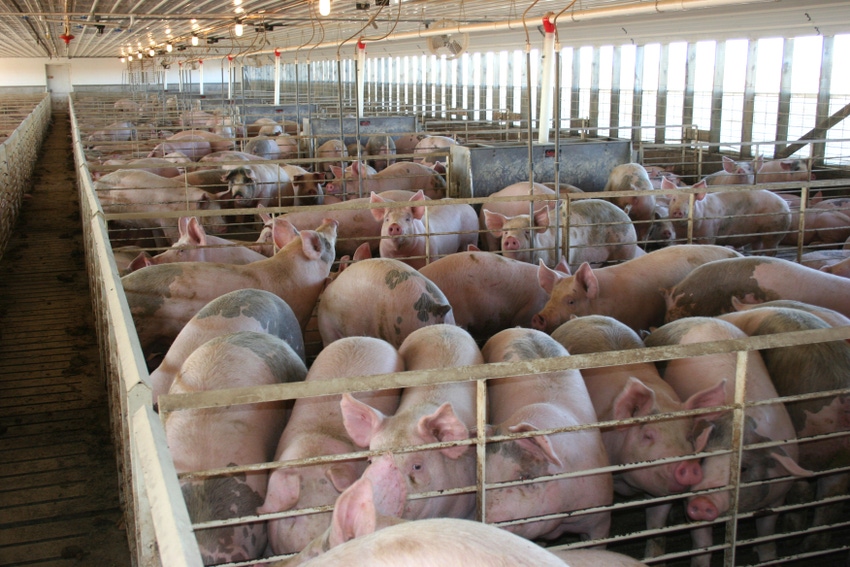U.S. hog farmers face $5b in losses, need ‘lifeline’
Industry raises several measures with federal policy-makers, including for USDA to purchase $1 billion in pork products.

After a challenging 2018 and 2019 due to trade negotiations, U.S. pork producers are now being severely affected by COVID-19. Hog values have plummeted, creating a financial disaster for pork producers nationwide, who face a collective $5 billion loss for the remainder of the year, according to the National Pork Producers Council (NPPC).
"We remain committed to supplying Americans with high-quality U.S. pork but face a dire situation that threatens the livelihoods of thousands of farm families," NPPC president Howard "A.V." Roth, a pork producer from Wauzeka, Wis., said during a press conference Tuesday.
"We are taking on water fast. Immediate action is imperative, or a lot of hog farms will go under," he said.
The suspension of pork packing plant operations and rising employee absenteeism due to COVID-19 has exacerbated an existing harvest facility capacity challenge due to a labor shortage in rural America. With limited harvest capacity, a surplus of pigs exists, causing hog values to plunge. The loss of the foodservice market (i.e., restaurants) and the COVID-19-related slowdown in most export markets has crashed demand and overwhelmed the cold storage of meat.
Dr. Dermot Hayes, an economist with Iowa State University, and Dr. Steve Meyer, a pork industry economist with Kerns & Associates, estimate that hog farmers will lose nearly $37 for each hog marketed for the rest of the year, or almost $5 billion collectively. Prior to the COVID-19 crisis, and after two challenging years, hog farmers were generally expecting a profitable year, with industry analysts forecasting earnings of approximately $10 per hog, on average, for 2020. The economic impact analysis by Hayes and Meyer was based on live hog futures between March 10 and April 10, 2020.
As of right now, Nick Giordano, NPPC vice president and counsel, global government affairs, said producers could even see losses of $50 per hog.
For a lot of the producers today, he said it costs more to feed the hog than the price producers can get for the hog.
“They need a lifeline, and they need it fast, or we are going to lose a lot of producers,” Giordano emphasized.
Roth explained that the pork industry is based on a just-in-time inventory system. As such, hogs are backing up on farms with nowhere to go, leaving farmers with tragic choices to make.
“Dairy producers can dump milk. Fruit and vegetable growers can dump produce, but hog farmers have nowhere to move their hogs," he said.
While pork industry leaders were unable to confirm that piglets are being euthanized, they said it could come to that if the situation gets worse.
Hayes said the plants that are currently closed represent only approximately 7% of the processing capacity, leaving 93% still available.
Further, he said any pigs that are potentially being euthanized would have come to market in the fall of this year. “In coincidence, we had a record-large number of pigs that were supposed to come to market at that time. So, the modest number of euthanized pigs would be small relative to the huge number of pigs that were scheduled to be in the packing plants in September-December,” Hayes said.
Still, NPPC chief executive officer Neil Dierks said more processing plants may need to close at any moment, and some have not been running at full capacity because there’s no outlet for the meat.
Taking all of this into consideration, NPPC, in consultation with hog farmers across the nation, identified several measures it has raised with federal policy-makers.
First, NPPC is asking the U.S. Department of Agriculture to make more than $1 billion in pork purchases to clear out a backed-up meat supply, supplementing agency food bank programs that are facing increased demand due to rising unemployment. These purchases should accommodate pork products packaged for restaurants and other segments of the foodservice market that have been affected by COVID-19.
The second request is for equitable direct payments to producer participants without eligibility restrictions. NPPC noted that when the last Market Facilitation Program payments were dispersed, only about 26% of hogs were covered. The pork industry does not have a supply management program, so USDA used criteria from other types of farm enterprises. One limitation was partnerships, but the pork industry has a lot of producer partnerships. This limited which producers could receive the payments. This is why NPPC is asking USDA to be as broad as possible in eligibility restrictions.
NPPC is also seeking a legislative fix to emergency loan programs that have left farmers out. Approximately 10,000 family hog farms are in jeopardy because they do not have access to much-needed capital offered by the Small Business Administration. NPPC urged Congress to increase the cap on qualifying businesses to those that employee up to 1,500 and to make agricultural businesses eligible for the Economic Injury Disaster Loan program.
“We are talking to the Administration every day,” Giordano said. “Our producers are talking to their members of Congress, their governors.”
He added, “Our hope is that we have swift and meaningful relief.”
About the Author(s)
You May Also Like





